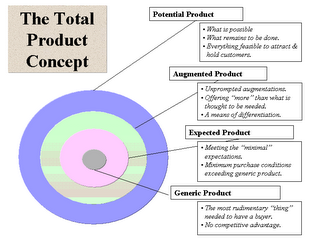The Whole Product
When someone buys a Wintel(Windows Intel) PC, they are buying the ability to choose from dozens of models from hundreds of hardware suppliers, or have one built to order, or build one themselves. They are buying the ability to access hundreds of peripherals, hundreds of thousands of applications, and millions of websites that work best with their system.
The point is that when someone buys and uses a product, the technological aspects are a small and often uninteresting part of the decision, whether this be conscious or not. When you choose a new computer, you are also buying into a vast infrastructure of capabilities, services and support. These include the availability of cheap software on every high street, cheap hardware additions, and the ability to use the same format as your friends (to save a file and have it compatible elsewhere, or send it via email to another computer without problems), the ability to buy hardware such as a printer and know it will just work.
They are buying the choice of hundreds of magazines, thousands of books, and all the supporting services from educational courses to repair shops.
They are also buying the confidence that their system will keep progressing even if individual manufacturers fail.
In marketing terms, "the core product" - such as a car, a computer, or a video recorder - is just the start. You have to add on all the things like reliability, service and support (the expected product), its expansion capabilities (the augmented product), and its potential for future development (the potential product) to get "the whole product".
Since real people make real buying decisions based on "the whole product" (and if they didn't, we'd change the model), simpleminded comparisons of products by technological feature are very likely to get it wrong.

This model by Geoffery Moore in Crossing the Chasm was introduced to me last year as part of my masters degree course in ICT entrepreneurship. I have applied it where possible ever since.

0 Comments:
Post a Comment
<< Home